Papers by Mathijs Van Vliet
New concepts for development of integrated multi-scale
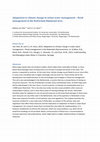
Many large coastal cities are located in deltas, which makes them vulnerable to floods. In many p... more Many large coastal cities are located in deltas, which makes them vulnerable to floods. In many places flood damages have increased due to an increase in people and assets in the cities. This process is expected to continue. At the same time, climate change causes floods to occur more often in many rivers and deltas due to higher discharges and sea level rise. These trends call for the development and implementation of new technologies and strategies in flood risk management. This call is also acknowledged in the Netherlands, a country that has a strong history of relying on structural measures. The city of Rotterdam includes many unembanked areas, of which large parts will be redeveloped in the near future. Current practise is to elevate all unembanked areas to a 1:4000 years flood level. This is not only very costly, but also causes problems when areas are redeveloped in phases, and in areas where plots of existing buildings will remain. Rotterdam therefore looks for adaptive (or non-structural) measures to decrease flood damages in these areas. Such measures are very little used in the Netherlands. One of the questions in Rotterdam is how these new measures fit within current policies, laws and regulations. This chapter describes the measures studied for a case study area in Rotterdam, an analysis of the policies, laws and regulations that affect these measures and the implication on adaptation to floods in urban flood management. Our research shows that in principal the rules allow for implementation. It is, however, problematic to enforce the measures, which can cause problems, e.g. when not all waterfront buildings are dry-proofed. Better communication of flood risks is recommended to increase awareness and preparedness, which might lead to a higher implementation of adaptive measures.
Njas Wagen J Life Sci, 2008
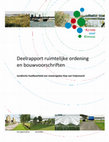
Nationaal Onderzoekprogramma Kennis voor Klimaat (KvK). Alle rechten voorbehouden. Niets uit deze... more Nationaal Onderzoekprogramma Kennis voor Klimaat (KvK). Alle rechten voorbehouden. Niets uit deze uitgave mag worden vermenigvuldigd, in geautomatiseerde bestanden opgeslagen en/of openbaar gemaakt door middel van druk, fotokopie, microfilm, geluidsband of op welke andere wijze ook, zonder voorafgaande schriftelijke toestemming van het Nationaal Onderzoekprogramma Kennis voor Klimaat. In overeenstemming met artikel 15a van het Nederlandse auteursrecht is het toegestaan delen van deze publicatie te citeren, daarbij gebruik makend van een duidelijke referentie naar deze publicatie. Aansprakelijkheid Hoewel uiterste zorg is besteed aan de inhoud van deze publicatie aanvaarden de Stichting Kennis voor Klimaat, de leden van deze organisatie, de auteurs van deze publicatie en hun organisaties, noch de samenstellers enige aansprakelijkheid voor onvolledigheid, onjuistheid of de gevolgen daarvan. Gebruik van de inhoud van deze publicatie is voor de verantwoordelijkheid van de gebruiker.
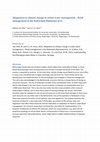
Many large coastal cities are located in deltas, which makes them vulnerable to floods. In many p... more Many large coastal cities are located in deltas, which makes them vulnerable to floods. In many places flood damages have increased due to an increase in people and assets in the cities. This process is expected to continue. At the same time, climate change causes floods to occur more often in many rivers and deltas due to higher discharges and sea level rise. These trends call for the development and implementation of new technologies and strategies in flood risk management. This call is also acknowledged in the Netherlands, a country that has a strong history of relying on structural measures. The city of Rotterdam includes many unembanked areas, of which large parts will be redeveloped in the near future. Current practise is to elevate all unembanked areas to a 1:4000 years flood level. This is not only very costly, but also causes problems when areas are redeveloped in phases, and in areas where plots of existing buildings will remain. Rotterdam therefore looks for adaptive (or non-structural) measures to decrease flood damages in these areas. Such measures are very little used in the Netherlands. One of the questions in Rotterdam is how these new measures fit within current policies, laws and regulations. This chapter describes the measures studied for a case study area in Rotterdam, an analysis of the policies, laws and regulations that affect these measures and the implication on adaptation to floods in urban flood management. Our research shows that in principal the rules allow for implementation. It is, however, problematic to enforce the measures, which can cause problems, e.g. when not all waterfront buildings are dry-proofed. Better communication of flood risks is recommended to increase awareness and preparedness, which might lead to a higher implementation of adaptive measures.

ABSTRACT All over the world, governments are considering how to deal with the issue of climate ch... more ABSTRACT All over the world, governments are considering how to deal with the issue of climate change and its possible consequences. Most energy is devoted to the question of how to mitigate climate change by reducing CO2 emissions. However, there is growing evidence that climate change will be irreversible and will have serious threatening consequences. Therefore, the issue of how we can and have to adapt to changing climate conditions is coming more and more onto the political and administrative agenda (IPCC, 2012). The taboo that for a long time rested on adaptation is slowly being lifted (Pielke et al., 2007). The policy domain of climate change adaptation is thus relatively new; this means that policy ambitions are still under construction, and the same holds for policy instruments and arrangements. In many countries, governments are still busy with exploring the possible impact of climate change, whereas in other countries authorities are drafting ambitious programmes to make society climate-proof. Many authors urge for more decisive action and are anxious about the indecisiveness that they are witnessing (Giddens, 2009; Hulme, 2009). The fact that climate change adaptation is still in its infancy also implies that there is a strong perceived need for policy-relevant information. Much time, money, and effort is invested in conducting technical analyses about what climate change can and does imply, which policy options are available, and how effective they are (Bruin et al., 2009). There is, however, also a growing need for information on how to govern climate change adaptation and deal with the specific challenges it poses; in other words, how to govern adaptation to climate change (Termeer et al., 2011). In particular, questions like how to mainstream adaptation into other policy arenas, how to mobilize private actors to finance adaptation measures, and how to connect short-term and long-term policy ambitions are important for many policymakers at multiple governance levels. Other questions relate to how to design institutional arrangements that fit the adaptation ambition (Hallegatte, 2009). In this chapter, we substantiate our argument that the status of climate change adaptation and the characteristics of this emerging domain are fertile ground for action-oriented research approaches. In the next section, we show that climate change adaptation is as much a governance challenge as a technical issue. In the third section, we argue that, because it is an immature policy domain and because policymakers are faced with huge uncertainties and controversies, a more collaborative interaction between social scientists and policymakers or planners could be helpful in realizing more effective governance strategies. Then we describe in more depth the expected benefits of action research in the context of climate change adaptation. Thereafter, we formulate the key questions to be answered in this book. The final section gives an overview of the remaining chapters.
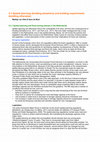
Mathijs van Vliet & Hans de Moel 5.3.1 Spatial planning and flood zoning policies in the Netherla... more Mathijs van Vliet & Hans de Moel 5.3.1 Spatial planning and flood zoning policies in the Netherlands Spatial planning can effectively reduce the vulnerability of an area, and thus the consequences of flooding (Schelfaut et al., 2011; van Herk et al., 2011). Not only water management has a long tradition in the Netherlands, but so has spatial planning. Below, we will review the policies and legislation that affect flood zoning in the Netherlands Table 2 gives an overview of these policies and legislation, a short description of their content and their implications for flood risk reduction. European legislation As part of the European Union (EU), EU regulations affect the Dutch regulations. After a number of severe floods, the EU developed the European Flood Directive (2007). It offers a framework for assessing flood risks and guidelines for decreasing negative consequences of floods. Member states need to develop flood damage and flood risk maps, which serve as basis for flood risk management plans. (website Flood directive, 2011) The new Water Act (or Water Law) of 2009 incorporates the EU Flood Directive in the Dutch legislation. The Netherlands national policy framework General policy The Netherlands has incorporated the European Flood Directive in its legislation, but there is still little attention to flood zoning. Land use planning as well as water management, however, have a long tradition in the Netherlands. Because of the high protection standards of the embankments spatial planning gives little to no attention to floods. For the unprotected areas the state has developed the Major Rivers policy, which states that the primary function of the major rivers and their floodplains is to discharge water to the sea. New activities in the floodplains are only allowed under a number of rules which aim to maintain the rivers' discharge capacity (Ministry of Transport Public Works and Water Management, 2006): The policy guideline Major Rivers uses a five step approach. In the first four it discerns between the type of activity and the place where it is executed. A division is made between areas with a storage regime (areas that mainly store water during high flows) and a discharge regime (areas through which the river discharges). Some un-embanked areas contribute little to the overall discharge capacity and are therefore excluded from the guideline. The fifth step lists a number of conditions that should be met, such as: • Activities need to be situated in such a way that the safe functioning of the river and its flood defence systems is maintained; • They form no barrier for increasing the rivers discharge capacity in the future; • The increase in water level or decrease of storage capacity should be minimized, and • The increase in water level and decrease in storage capacity should be compensated, except for small and temporary activities and activities needed for river management. Legislation The policy framework Major Rivers is enforced via the Dutch spatial planning regulations (Ministerie van Infrastructuur en Milieu, 2011) and the Water Act (Ministry of Transport Public Works and Water Management, 2009). The spatial planning regulations contain extra rules and regulations. It aims to protect national interests, like maintaining the discharge capacity of the major rivers. The spatial planning act states that municipalities should develop land use zoning plans ('Bestemmingsplan') every 10 years. They have to incorporate legal rules from higher government layers. By law, the land used zoning plans should always be financially possible. For areas that will be redeveloped or newly developed land use zoning plans could very well be used for flood zoning. Land use zoning plans, however, cannot enforce land use changes but only allow for a certain use. A new function can only be assigned when it is clear that the old function
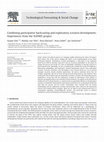
Technological Forecasting and Social Change, 2011
Social, natural and cultural systems are changing rapidly, influencing the future of Europe's fre... more Social, natural and cultural systems are changing rapidly, influencing the future of Europe's fresh waters. One of the drivers shaping this future is the implementation of the Water Framework Directive. Participatory scenario development is well-suited to the challenges posed by the WFD to develop a long-term view by involving stakeholders. In this paper we analyse the process and results of a series of stakeholder workshops to develop scenarios at pan-European level. Specifically, we aim at analysing the method and results of combining a backcasting methodology and exploratory scenario development process. Four exploratory scenarios (narrative storylines) were developed, in first instance based on a set of existing European scenarios. Results matched expectations; the process produced stories that are complex, integrated, and rich in detail. During the backcasting exercise, four timelines were constructed, each of which took one exploratory scenario as context. The backcasting process established a strong link with the exploratory scenarios by identifying a large number of obstacles and opportunities in the realisation of those timelines. An analysis across all backcasts yielded a list of 15 robust elements, i.e. elements that are potentially effective in all exploratory scenarios. A stakeholder questionnaire showed that overall there was a widespread satisfaction with both the process and the results. Stakeholders were satisfied with the overall methodology and the exploratory scenarios and somewhat more critical on the backcasting exercise and resulting robust strategies. Above all, we hope to have demonstrated that it is conceptually appealing, methodologically feasible, and practically useful to combine exploratory scenario development and backcasting analysis.
... Futures: The Practice of Environmental Scenario Analysis J. Alcamo,pp. Chapter 6. Axelrod, R.... more ... Futures: The Practice of Environmental Scenario Analysis J. Alcamo,pp. Chapter 6. Axelrod, R., 1976. Structure of decision: the cognitive maps of political elites. Princeton University Press, Princeton, NJ. Biggs, R., C. Raudsepp-Hearne, C. Atkinson-Palombo, E. Bohensky, E ...
Uploads
Papers by Mathijs Van Vliet